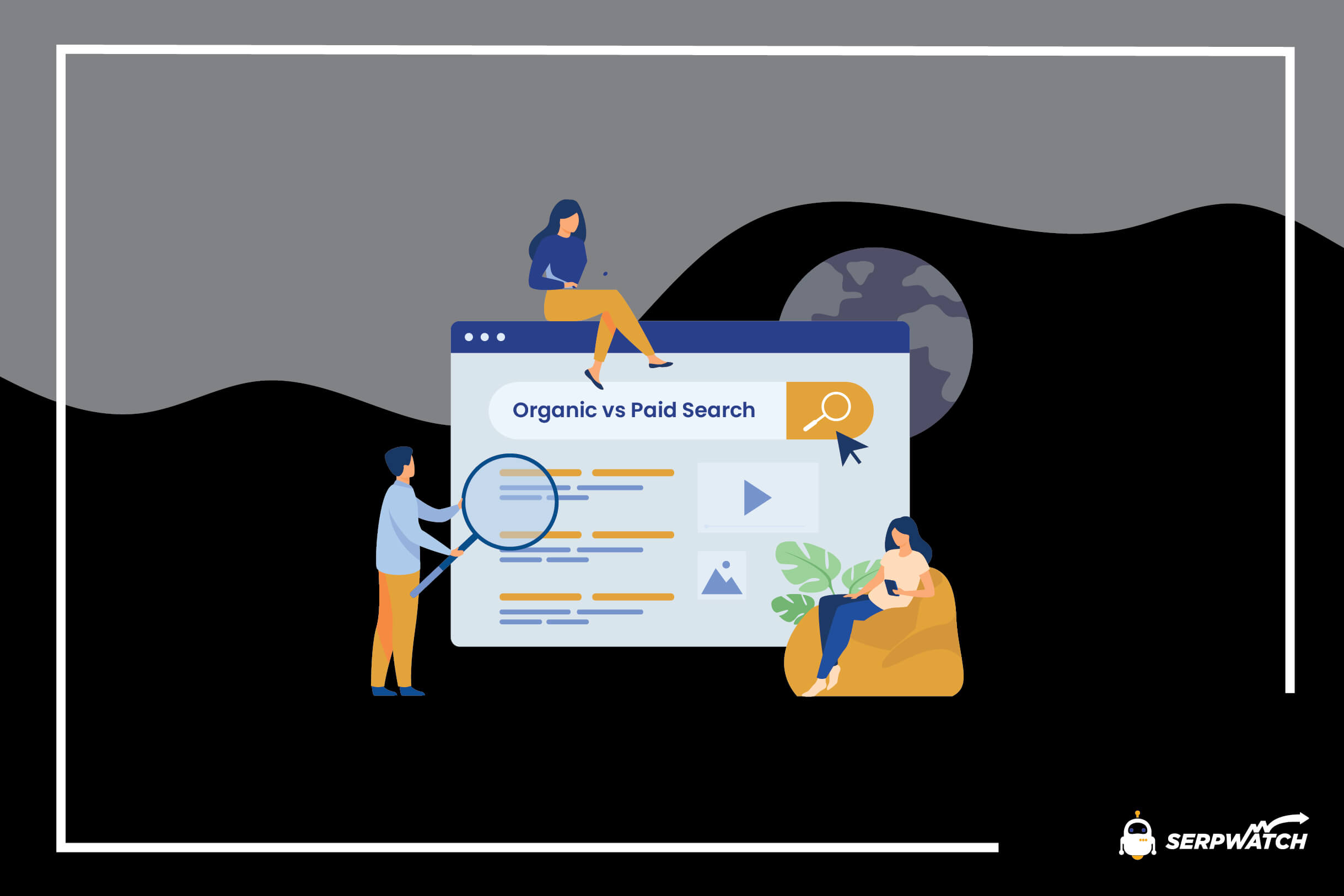
Organic vs. Paid Search—Which One Is a Better Investment in 2024?

Being successful at search engine marketing (SEM) comes down to finding the balance between free and paid tactics to rank better on the search engine results page (SERP). The higher a website appears, the more traffic it gains, the better its chances for conversions.
However, a good marketing strategy is often a combination of various methods. Below, you’ll see whether this universal rule also applies to the organic vs. paid search dilemma.
Find in this article
- What is the definition of organic search?
- How to generate organic traffic
- Does paid search impact organic search?
- How to differentiate organic from paid search results
- How to integrate organic and paid marketing into one strategy
- When to use organic and when to use paid social media strategy
- Is SEO more beneficial for a business than PPC?
What Is Organic Search?
Organic search is the process of using an unbiased algorithm to provide users with suggestions based on their search input. That’s a non-disruptive way of distributing content. On the other hand, paid search allows advertisers to highlight their pages via the pay-per-click (PPC) model.
Internet users seem to be dissatisfied with any interruptive and aggressive marketing now more than ever. According to the most recent research, 49% of advertisers consider organic the best approach. Therefore, marketers need to understand how search engine optimization (SEO) works and their target audience’s needs to rank higher.
How to Get Organic Traffic
Every business wants its website to rank higher than its competitor’s website. So, organic search is a vital source of traffic.
While other traffic sources usually lead to one-page site visitors, organic search aims for customer loyalty and increases the overall website traffic and conversion rate. These advantages define organic marketing and distinguish it from paid strategies.
Mobile optimization, SEO, social media engagement, and natural link building are essential steps for increasing organic traffic. Furthermore, you can make use of some long-standing SEO tips and have metadata on each page to help search engines better understand the website’s content.
Other essential tools for increasing organic traffic over time are image tags with alt attributes, page descriptions, and title tags with the most relevant keywords. Furthermore, mobile-friendly designs are necessary, as smartphones and tablets are a big part of daily life.
Does Paid Search Help Organic Search?
Paid search can help with better content ranking and organic traffic. However, it may not always bring the desired results because numerous factors affect the website’s position among the search results.
To better understand paid search, it’s essential to know how search engine rankings are connected to click-through rates. Going up even one position on the SERP can have a significant effect. According to SEO statistics, to get a good click-through rate of 4–5%, the page must appear at least fifth in the search results.
Now, let’s explore further how organic and paid search can work together. Seeing an ad once is enough for internet users to feel familiar with a brand, and marketers can exploit this phenomenon of human behavior.
The more times a particular brand’s ad appears in the search results, the higher the chance people will click on it. This strategy works well when the ad appears together with organic listings. This way, paid search indirectly increases the brand’s organic traffic.
What Is the Difference Between Paid Results and Organic Results?
Organic results appear based on their relevance to the term a person types into the search engine. On the other hand, paid results pop up because advertisers use the pay-per-click model to make their content available to searchers.
Many marketers choose to display ads because they ensure high user and keyword visibility. It’s a successful strategy to increase the number of website visitors in a short period.
So, paid results come from sponsored advertising, while organic results answer the keywords used for an inquiry. Search engines rank organic results based on their relevance. Paid results, however, appear on top of the page, marked with “Ad” to be distinguished from the organic ones.
What Is the Difference Between Paid and Organic Traffic?
As search engines are the usual starting point of any online experience, marketers try to understand their algorithms to get their content to appear higher on the SERP. Good ranking generates more website traffic, which leads to more conversions.
Organic is a long-term source of traffic. Marketers need to create original content with optimized keywords on a fast-loading and responsive site to rank high. Engagement, links, and domain authority are also important factors. However, when it comes to organic traffic vs. paid traffic, both have advantages and disadvantages.
Paid traffic is also a good option that comes from business users clicking on paid ads. Other good practices include directing ads to a selected landing page with a special offer or a conversion form for collecting visitors’ data.
A pay-per-click strategy is designed to place a website in a search query that includes one or more keywords the business is bidding for. Before paying for ads, it’s necessary to select keywords, design striking ads, and plan a budget.
What Are Paid Search vs. Organic Search Pros and Cons?
The primary perks of paid search are increased visibility, ranking stability, and creating a custom audience. On the other hand, this marketing strategy comes with ongoing expenses and management and requires relevant experience.
Organic search, however, is free of charge and ensures the website has credibility and loyal visitors. Its disadvantage is that it requires time and commitment to reach the desired results. What’s more, the outcomes often fluctuate depending on socio-economic events and seasons.
What Is Google Search Engine Marketing?
Search engine marketing (SEM) is another type of digital marketing often used to increase website visibility in SERPs. Nowadays, SEM refers only to paid search advertising, while in the past, this term implied both organic and paid search activities.
According to search engine statistics, Google remains a global leader with a market share of 86.1%, while Bing and Yahoo accounted for 7.2% and 2.7% in December 2021. That’s why marketing strategies primarily focus on Google paid search results.
Google’s paid search platform, commonly known as AdWords, enables companies to specify a budget, set maximum bid price, choose specific keywords, and create ads. It works on the PPC principle, and businesses pay a fee to Google whenever a user clicks on their ad. The amount varies depending on the keyword, as the competition can raise the bid price.
However, when it comes to Google AdWords vs. SEO, both options have positive and negative sides. For example, AdWords is limited to Google, while SEO covers all search engines. On the other hand, SEO works only for SERPs, while AdWords enables advertising on all Google websites and websites that use Google Adsense.
In addition, SEO requires a lot of time and effort to rank a website high on the search engine result page and increase traffic. At the same time, AdWords ads can be found on the top of Google search results and present an instant solution for gaining website traffic.
SEO Versus PPC—Which Is Right for Your Business?
You need to consider a few things when choosing the right strategy for your needs. SEO generates traffic for free, while PPC requires payment for each click. On the other hand, paid ads appear above optimized websites on search engine listings.
Furthermore, around 45% of small businesses include paid ads in their marketing strategies, as organic vs. paid search statistics for 2021 reveal. They focus on local markets and require just a few leads per week to accomplish good visibility by spending small amounts of money on PPC.
However, the latest research reveals that combining the two options is more successful for businesses that depend on aggressive and high-growth digital marketing. The simultaneous utilization improves the results of both strategies and significantly increases brand awareness.
When Is the Best Time to Use Organic vs. Paid Social Media Strategy?
Organic social media is any activity that doesn’t include paying for promotion. Businesses use various free tools to engage the audience and build an online presence. On the other hand, paid social media refers to sponsored posts and ads that work on the PPC principle.
The comparison between paid and organic social media is similar to what we discussed about organic search vs. paid search. The two strategies are most potent when combined. After implementing organic social media to showcase the content and brand’s values, it’s best to include paid posts to reach the target audience more efficiently.
Paid social media helps brands connect with consumers when the organic reach is low by breaking through algorithms. Alternatively, the organic approach is crucial for promoting a business through social sharing. It’s the more discrete option because people don’t appreciate interruptive and aggressive marketing.
Experimenting with free or low-cost methods, like email campaigns, and picking the most successful option for paid social strategy is a better approach than investing in all processes simultaneously.
Organic vs. Paid Marketing—How to Combine Them in a Marketing Strategy
These two digital marketing strategies give better results when combined. After creating and publishing content regularly, it’s good to drive more traffic by launching a paid marketing campaign. Depending on the results, there may be a need to boost social media posts additionally with linked content.
Integrating both strategies is the best answer to the organic vs. paid search dilemma. Increasing traffic in a short time is best achieved by feeding conversion and keyword data from paid marketing into an organic process.
Analyzing keyword performance data from paid marketing gives an excellent opportunity to improve organic marketing methods like SEO. This way, you’ll build long-lasting connections with consumers while ensuring that paid promotion reaches as many people as possible.
Organic vs. Paid Search—The Takeaway
Businesses worldwide invest a lot in the competition for the target audience’s attention. SERP ranking has a tremendous influence on website traffic, and it’s essential to understand the way the search engine algorithm works to maximize the visibility of a website.
Businesses often overlook that it’s all about striking the right balance when it comes to deciding on organic search vs. paid search. To create the best strategy, marketers need to consider factors like marketing goals, available budget, and audience behavior. In addition, the number of backlinks and content quality also have an enormous impact on search engine listing.
For a successful marketing strategy, it’s vital to invest in applications like SerpWatch. With keyword suggestions and Google Analytics integrations, this feature-rich rank tracker can help optimize every business strategy and rise above the common organic vs. paid search dilemma.
Sources: Higher Visibility, PPC Protect, Statista, WordStream






There are currently no comments.
Be the first!))